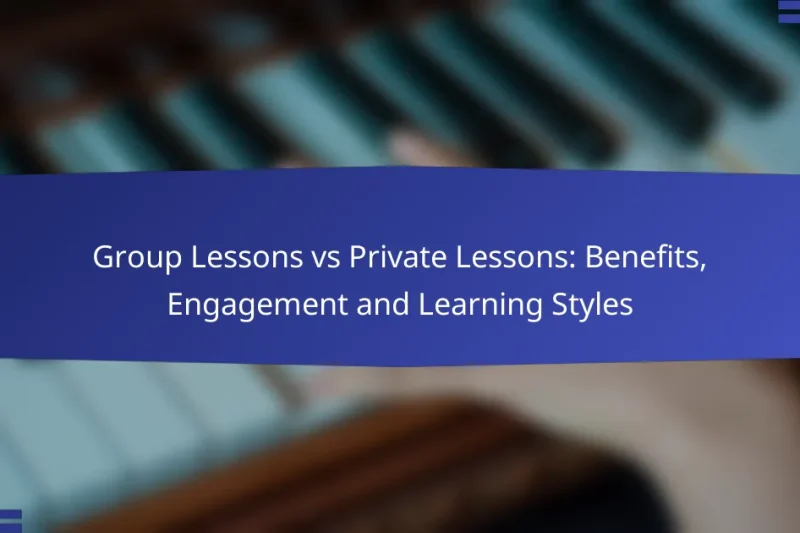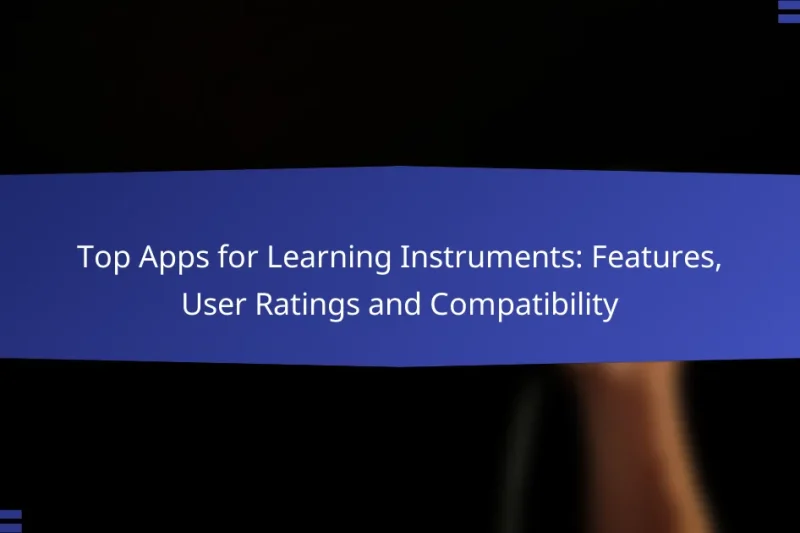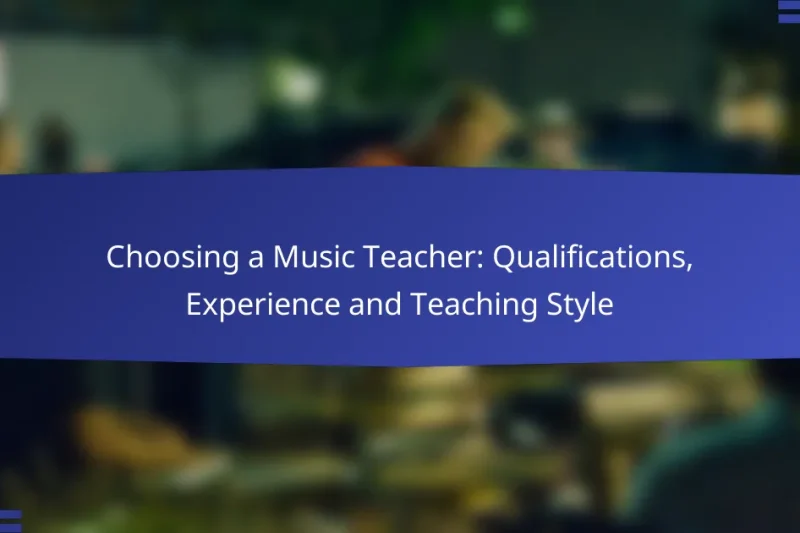When considering educational options, the choice between group lessons and private lessons can greatly influence a … Group Lessons vs Private Lessons: Benefits, Engagement and Learning StylesRead more
Musical Instrument Learning Resources
Exploring musical instrument learning resources can greatly enhance your journey as a musician, whether you’re a beginner or looking to refine your skills. From online platforms offering interactive lessons to local music teachers who can provide personalized guidance, there are numerous options available. Additionally, self-teaching resources like books, videos, and apps can complement your learning experience and help you master your instrument effectively.
Top Apps for Learning Instruments: Features, User Ratings and Compatibility
Discover the top apps for learning instruments that cater to a wide range of skill levels … Top Apps for Learning Instruments: Features, User Ratings and CompatibilityRead more
Choosing a Music Teacher: Qualifications, Experience and Teaching Style
Choosing the right music teacher is crucial for your musical journey, as it involves evaluating their … Choosing a Music Teacher: Qualifications, Experience and Teaching StyleRead more
What are the best online platforms for learning musical instruments?
The best online platforms for learning musical instruments offer interactive lessons, structured tutorials, and expert guidance tailored to various skill levels. These platforms cater to different instruments and learning styles, making it easier for users to find the right fit for their musical journey.
Yousician for interactive lessons
Yousician provides an engaging way to learn musical instruments through interactive lessons that adapt to your skill level. Users can learn guitar, piano, bass, and ukulele, with real-time feedback on their playing. The app includes a vast library of songs and exercises, making practice enjoyable and effective.
Consider using Yousician if you prefer a gamified learning experience. The platform tracks your progress and offers challenges to keep you motivated. However, be aware that a subscription is required for full access to all features.
Guitar Tricks for guitar-focused tutorials
Guitar Tricks specializes in guitar lessons, offering over 11,000 video tutorials covering various styles and techniques. The platform is designed for beginners to advanced players, providing a structured learning path with step-by-step guidance. Users can access a wide range of genres, from rock to blues.
One of the standout features is the 14-day free trial, allowing you to explore the content before committing. Guitar Tricks also includes practice tools and a community forum for additional support, making it a solid choice for guitar enthusiasts.
Simply Piano for piano learners
Simply Piano is an app designed specifically for piano learners, offering a user-friendly interface and a wide array of songs. It uses a combination of audio recognition and visual cues to help users learn to play at their own pace. The lessons are structured to gradually build skills, making it suitable for all ages.
Take advantage of the app’s song library, which includes popular music and classical pieces. Simply Piano also offers a free trial, but full access requires a subscription. This platform is ideal for those who enjoy learning through familiar songs.
Fender Play for guitar and bass
Fender Play focuses on teaching guitar and bass through a series of video lessons that cater to beginners and intermediate players. The platform offers a straightforward learning path, with lessons organized by skill level and musical style. Users can choose from various genres, including rock, blues, and country.
Fender Play provides a free trial, allowing you to explore its features before subscribing. The platform also includes practice tools and a community for support, making it a great option for those looking to learn guitar or bass in a structured environment.
MasterClass for expert-led courses
MasterClass offers courses taught by renowned musicians, providing insights and techniques from industry experts. While not instrument-specific, the platform covers a range of musical topics, including songwriting, performance, and production. This makes it suitable for those looking to deepen their overall musical knowledge.
Each course includes video lessons, downloadable materials, and assignments to enhance learning. However, MasterClass requires a subscription for full access, and the focus is more on artistic development than technical skill building. It’s ideal for those seeking inspiration from successful musicians.
How can I find local music teachers?
To find local music teachers, start by exploring online platforms, local listings, and community resources. These methods can help you connect with qualified instructors in your area who match your musical interests and learning style.
Use TakeLessons for local instructors
TakeLessons is an online platform that connects students with local music teachers. You can filter instructors by instrument, location, and availability, making it easy to find someone who fits your schedule and needs.
When using TakeLessons, read reviews and check the instructors’ backgrounds to ensure they have the appropriate experience. Prices typically range from $30 to $80 per hour, depending on the teacher’s expertise and location.
Search on Thumbtack for music teachers
Thumbtack allows you to search for music teachers in your area by entering your specific needs and preferences. You will receive quotes from various instructors, enabling you to compare prices and services easily.
Consider looking for teachers who offer trial lessons, which can help you gauge their teaching style before committing. Rates on Thumbtack can vary widely, often starting around $25 per session.
Check Craigslist for local ads
Craigslist can be a useful resource for finding local music teachers advertising their services. Browse the “Lessons” section under your city’s category to find listings from various instructors.
While Craigslist can offer lower rates, be cautious and verify the credentials of any teacher you consider. Always arrange to meet in a public place for initial lessons to ensure safety.
Visit local music stores for recommendations
Local music stores often have bulletin boards with advertisements from music teachers or can provide recommendations based on their network. Staff members are usually knowledgeable about the local music scene and can suggest instructors who specialize in your desired instrument.
Additionally, some music stores offer lessons on-site, which can be a convenient option. Prices for lessons at music stores may be similar to those found online, generally ranging from $30 to $70 per hour.
What are the best resources for self-teaching musical instruments?
The best resources for self-teaching musical instruments include a mix of books, online videos, forums, and mobile applications. These tools cater to various learning styles and can significantly enhance your practice and understanding of your chosen instrument.
Books like “The Complete Guitar Manual”
Books such as “The Complete Guitar Manual” provide comprehensive guides for beginners and advanced players alike. They typically cover essential techniques, music theory, and practical exercises that help learners progress at their own pace.
When selecting a book, consider your instrument and skill level. Look for titles that offer clear instructions, illustrations, and accompanying audio or video resources for a more interactive experience.
YouTube channels like JustinGuitar
YouTube channels like JustinGuitar offer free, high-quality video tutorials that cater to various skill levels. These channels often break down complex techniques into manageable steps, making it easier for learners to follow along.
To maximize your learning, subscribe to channels that align with your musical interests and regularly practice the techniques demonstrated. Engaging with the community through comments can also provide additional insights and motivation.
Online forums like Ultimate Guitar
Online forums like Ultimate Guitar serve as valuable platforms for musicians to share tips, ask questions, and seek feedback. These communities allow users to connect with fellow learners and experienced players, fostering a supportive environment for growth.
Participating in discussions can enhance your understanding of various techniques and styles. Be sure to explore different threads and contribute your own experiences to enrich the community.
Mobile apps like GarageBand for practice
Mobile apps like GarageBand offer versatile tools for practicing and recording music on the go. These applications often include features such as virtual instruments, metronomes, and recording capabilities, making them ideal for self-teaching musicians.
When using mobile apps, set specific practice goals and utilize the app’s features to track your progress. Experiment with different functionalities to discover what best supports your learning journey.
What are the essential tools for learning an instrument?
Essential tools for learning an instrument include a metronome, tuner apps, and sheet music. These resources help develop timing, pitch accuracy, and structured learning, making the practice process more effective and enjoyable.
Metronome for timing practice
A metronome is a device that produces a steady beat, helping musicians maintain consistent timing. It is crucial for developing rhythm and can be set to various tempos, typically ranging from 40 to 208 beats per minute.
When using a metronome, start at a slower tempo and gradually increase the speed as you become more comfortable. Many digital metronomes offer features like subdivisions and different time signatures, which can enhance your practice sessions.
Common pitfalls include setting the metronome too fast too soon or ignoring its use altogether. Make it a habit to practice with a metronome regularly to improve your timing skills.
Tuner apps for pitch accuracy
Tuner apps are essential for ensuring that your instrument is in tune, which is vital for developing pitch accuracy. These apps typically use your device’s microphone to detect the pitch of the sound being played and provide real-time feedback.
Most tuner apps display whether the note is sharp, flat, or in tune, allowing you to make necessary adjustments. Look for apps that offer a variety of tuning modes, such as chromatic or specific instrument settings, to suit your needs.
Be cautious of relying solely on visual feedback; also train your ear to recognize pitch discrepancies. Regularly check your tuning before practice sessions to ensure optimal sound quality.
Sheet music for structured learning
Sheet music provides a written representation of music, offering a structured approach to learning an instrument. It helps musicians understand musical notation, rhythm, and dynamics, which are essential for performance.
When selecting sheet music, choose pieces that match your skill level and gradually increase in complexity. Many online resources offer free or paid sheet music across various genres, making it easy to find suitable materials.
To maximize learning, practice sight-reading regularly and break down complex pieces into manageable sections. Avoid the temptation to skip challenging parts; addressing them will enhance your overall musicianship.
How do I choose the right instrument for me?
Choosing the right musical instrument involves considering your personal interests, physical comfort, and budget. By evaluating these factors, you can select an instrument that enhances your learning experience and enjoyment.
Consider your music genre preferences
Your music genre preferences play a crucial role in instrument selection. For example, if you enjoy rock music, you might gravitate towards electric guitars or drums, while classical enthusiasts may prefer the violin or piano. Identifying the genres that excite you can help narrow down your options.
Additionally, think about the artists and bands you admire. Their instrumentation can provide insight into what you might enjoy playing. Listening to different styles can also inspire you to explore instruments that align with those sounds.
Assess your physical comfort with instruments
Physical comfort is essential when choosing an instrument. Consider the size, weight, and playability of the instrument. For instance, a large guitar may be challenging for a smaller individual to handle, while a lightweight flute might be more accessible.
It’s beneficial to try out various instruments in person, if possible. Visit a local music store or community center to test different options. Pay attention to how the instrument feels in your hands and whether you can play it comfortably for extended periods.
Evaluate budget and maintenance costs
Your budget will significantly influence your instrument choice. Prices can vary widely; for example, beginner guitars may range from $100 to $500, while professional models can exceed $2,000. Set a budget that includes not just the purchase price but also ongoing maintenance costs.
Consider additional expenses such as accessories, lessons, and repairs. Some instruments, like pianos, may require regular tuning, while others, like ukuleles, typically have lower maintenance needs. Researching these costs upfront can help you make a more informed decision.


